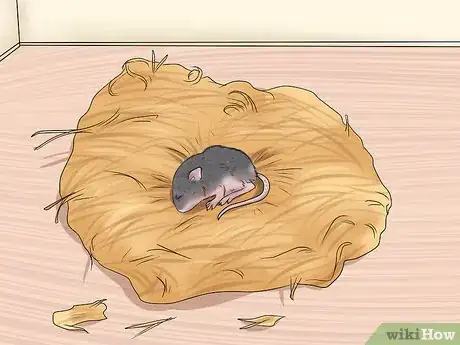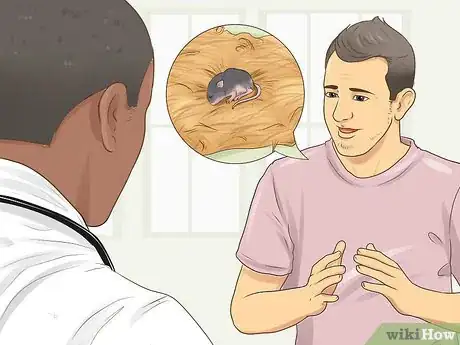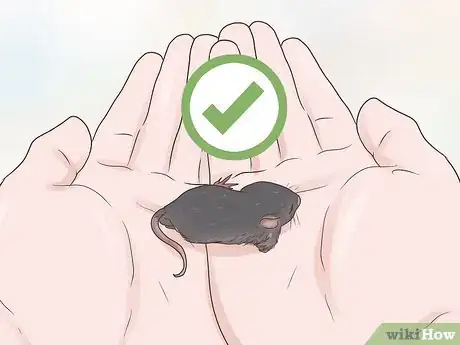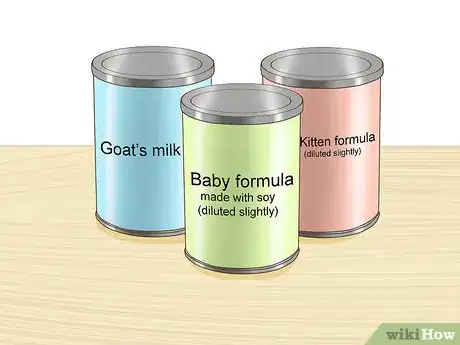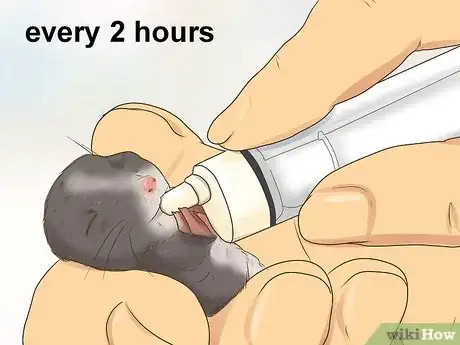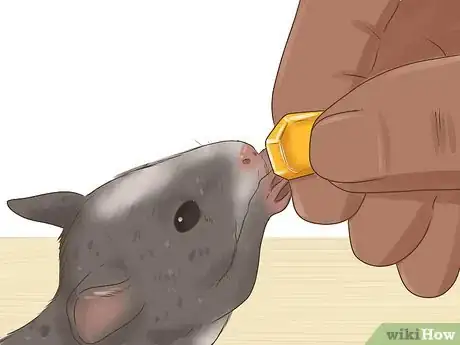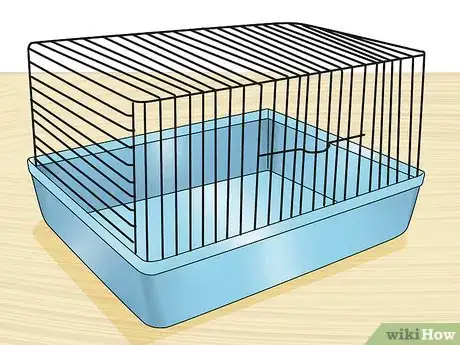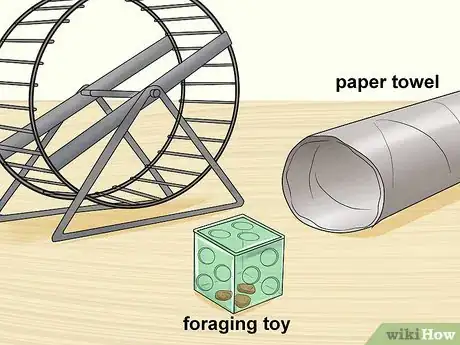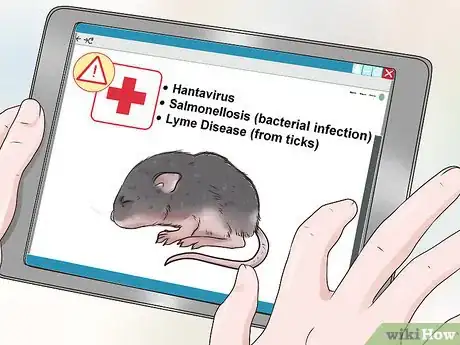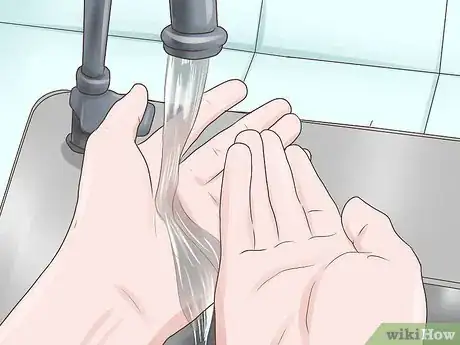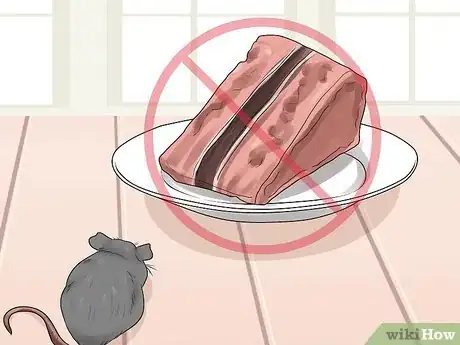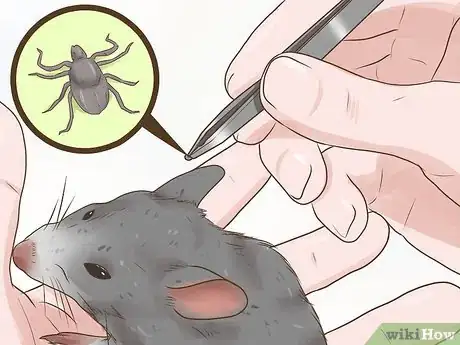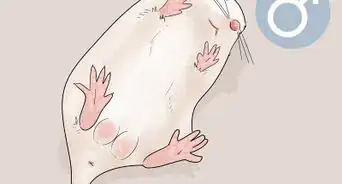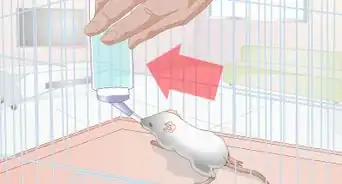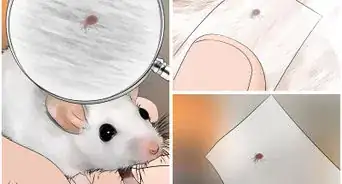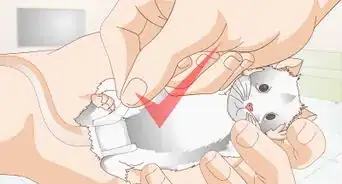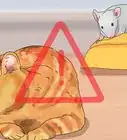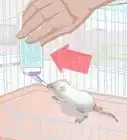This article was co-authored by Deanne Pawlisch, CVT, MA. Deanne Pawlisch is a Certified Veterinary Technician, who does corporate training for veterinary practices and has taught at the NAVTA-approved Veterinary Assistant Program at the Harper College in Illinois and in 2011 was elected to the board of the Veterinary Emergency and Critical Care Foundation. Deanne has been a Board Member of the Veterinary Emergency and Critical Care Foundation in San Antonio, Texas since 2011. She holds a BS in Anthropology from Loyola University and an MA in Anthropology from Northern Illinois University.
There are 11 references cited in this article, which can be found at the bottom of the page.
wikiHow marks an article as reader-approved once it receives enough positive feedback. This article received 16 testimonials and 100% of readers who voted found it helpful, earning it our reader-approved status.
This article has been viewed 221,385 times.
If you have found a lost baby mouse, you may be inclined to take care of it. Although it is a lot of work, nursing a baby mouse to health can be done effectively. Your most important tasks will be to feed the mouse and provide it with a place to live. You should also be aware that—although transmission is rare—wild mice have been shown to carry some diseases. Finally, when dealing with the welfare of animals, it is always a good idea to speak to a local veterinarian for advice.
Steps
Rescuing an Abandoned Baby Mouse
-
1Ensure that the nest has been abandoned. If you come across a nest with no mother, you cannot immediately determine that she is gone for good. You may have simply frightened her or she may be out looking for food. Leave the nest (and mice) alone and check again later. If the mother is still absent, you may need to take action.[1]
- Try not to disturb the nest. But don't worry, mother mice will not reject babies who have been touched.
- Return again after 1-2 hours, and then again after another 1-2 hours.
- Check the babies' bellies for white bands known as "milk bellies." If you don't see these over the course of 4-6 hours, the babies have not been fed and are likely orphans.
-
2Seek help from a vet, when necessary. If the baby mouse has been attacked by a cat, you must seek the help of a veterinarian right away. Bacteria from the cat's mouth can cause a serious (often fatal) infection called "septicemia." A vet may be able to provide emergency treatment for the baby mouse.[2]
- Perform an internet search for veterinarians in your area.
- Call ahead to see if they can treat mice.
Advertisement -
3Handle mice carefully. Baby mice are small and docile, and must be handled with care. They should not squirm much, but you must still grasp them firmly when feeding to prevent falls. Additionally, it is important to note that wild mice have been shown to carry diseases.[3]
- You may choose to wear latex gloves when handling the mice.
- Whether or not you wear gloves, you must thoroughly wash your hands after handling.
Feeding the Mouse
-
1Provide liquid nourishment. Baby mice would ordinarily drink milk from their mother. Instead, you are going to need to provide that “milk” to you baby mouse.[4] Avoid cow's milk. Instead, you might choose:
- Baby formula made with soy (diluted slightly).
- Kitten formula (diluted slightly).
- Goat’s milk.
- Puppy milk replacer.
-
2Feed it every two hours. Your baby mouse is going to need to eat around the clock until it opens its eyes. For very young mice (0-2 weeks old), you must do this every two hours. After this, they only need to eat every 3-4 hours. Once their eyes are open, they should no longer need to eat during the night.[5]
- Warm up the milk. Test a drop on your wrist to make sure it is not too cold or too hot.
- Fill an eyedropper, syringe, or pipette with milk.
- Hold the mouse firmly with your non-dominant hand.
- Holding the pipette in your other hand, try to shimmy the tip into the mouse's mouth.
- Put drop of warm milk in then wait for him to swallow (this looks like stretching out and squirming).
- Offer the mouse as much milk as it wants.
-
3Include solid foods once eyes are open. When your mouse’s eyes are open, it can begin to eat some solid food. Continue giving it formula until the 4-6 weeks old, by which time it should be weaned.[6] You may give your mouse:
- Hamster food moistened with formula or goat’s milk.
- Kitten food (moistened).
- Human baby food (homemade or store-bought).
- Soft cooked vegetables like squash, peas, or carrots.
-
4Stimulate the mouse to help it go to the bathroom. Baby mice cannot urinate or defecate on their own. Normally, the mother would lick them to encourage them to eliminate. After a meal, dip a cotton ball or your finger in warm water. Gently, move it over the mouse's genitals until it has gone.[7]
Creating a Home for Your Mouse
-
1Set up a cage. You will need some kind of enclosure to house your baby mouse. That first night, you might begin with just a shoebox containing a kitchen towel. However, if you plan to make this mouse your pet, you will need something more permanent. As a general rule, you should provide one cubic foot (30.4 cubic cm) of space for your first mouse, and an additional 0.5 cubic feet (15.24 cubic cm) of space for each additional mouse in the same cage.[8] You must also clean the cage once a week. You may purchase one of the following at your local pet store:
- Glass aquarium.
- Metal cage.
- Plastic cage.
-
2Keep your mouse warm. If your mouse were in the wild, it would cuddle with its mother and siblings. In your home, you need to make sure that your baby mouse stays warm.[9]
- Spread wood shavings on the bottom of its cage.
- Keep the cage off the ground in your home.
- Keep the temperature in your home around 70 degrees F (21 degrees C).
- Place a heat source in one part of the cage. Use a hot water bottle wrapped in towels or put a heating pad under one half of the cage. Make sure that the mouse can move away if it is too warm.
-
3Include some toys. Mice need to exercise quite a bit, they need things to chew on, and they crave mental stimulation.[10] As your mouse begins exploring the cage, consider providing some of the following items:
- Exercise toys, like a mouse wheel or little balls with bells inside (normally sold as cat toys).
- Chew toys, like paper towel rolls or egg cartons.
- Foraging toys or food-hiding toys (created for birds and/or rodents).
Protecting Yourself Against Diseases
-
1Understand the risks. Although transmission rates are rather low, wild mice can carry diseases which could make you sick. Perform an internet search to determine the level of risk in your area. Take precautions to protect yourself.[11] For example a wild mouse can transmit:
- Hantavirus.
- Salmonellosis (bacterial infection).
- Lyme disease (from ticks).[12]
-
2Wash your hands. The very best way to prevent the spread of germs from your mouse is to wash your hands after you touch it. Before washing your hands, avoid touching your mouth, eyes, or any part of your face. Washing with soap and water is best, but if you are not able to, using alcohol-based hand sanitizer is another option.
- Wet your hands with water.
- Lather with soap (any soap is fine).
- Rub all surfaces of your hands.
- Rinse and dry your hands.
-
3Keep the mouse away from your food. Salmonella bacteria—which results in the condition Salmonellosis--can be spread by mice. As such, it is important to keep your mouse away from the food that you eat.[13]
- Never allow mice on countertops or in pantries.
- Keep all of your food in secure, sealed containers.
-
4Remove ticks. If you live in a region that is prone to ticks, be sure you check your mouse for ticks regularly (at least once a week). If you find a tick attached to your mouse, you will need to remove it.
- Wear rubber gloves.
- Clean the area with rubbing alcohol (try to smother the tick).
- Use tweezers to carefully pull the tick off of your mouse.
- Flush the tick down your toilet.
Expert Q&A
Did you know you can get expert answers for this article?
Unlock expert answers by supporting wikiHow
-
QuestionHow can I tell the age of a mouse?
 Deanne Pawlisch, CVT, MADeanne Pawlisch is a Certified Veterinary Technician, who does corporate training for veterinary practices and has taught at the NAVTA-approved Veterinary Assistant Program at the Harper College in Illinois and in 2011 was elected to the board of the Veterinary Emergency and Critical Care Foundation. Deanne has been a Board Member of the Veterinary Emergency and Critical Care Foundation in San Antonio, Texas since 2011. She holds a BS in Anthropology from Loyola University and an MA in Anthropology from Northern Illinois University.
Deanne Pawlisch, CVT, MADeanne Pawlisch is a Certified Veterinary Technician, who does corporate training for veterinary practices and has taught at the NAVTA-approved Veterinary Assistant Program at the Harper College in Illinois and in 2011 was elected to the board of the Veterinary Emergency and Critical Care Foundation. Deanne has been a Board Member of the Veterinary Emergency and Critical Care Foundation in San Antonio, Texas since 2011. She holds a BS in Anthropology from Loyola University and an MA in Anthropology from Northern Illinois University.
Certified Veterinary Technician
-
QuestionCan I feed my baby mouse puppy formula?
 Deanne Pawlisch, CVT, MADeanne Pawlisch is a Certified Veterinary Technician, who does corporate training for veterinary practices and has taught at the NAVTA-approved Veterinary Assistant Program at the Harper College in Illinois and in 2011 was elected to the board of the Veterinary Emergency and Critical Care Foundation. Deanne has been a Board Member of the Veterinary Emergency and Critical Care Foundation in San Antonio, Texas since 2011. She holds a BS in Anthropology from Loyola University and an MA in Anthropology from Northern Illinois University.
Deanne Pawlisch, CVT, MADeanne Pawlisch is a Certified Veterinary Technician, who does corporate training for veterinary practices and has taught at the NAVTA-approved Veterinary Assistant Program at the Harper College in Illinois and in 2011 was elected to the board of the Veterinary Emergency and Critical Care Foundation. Deanne has been a Board Member of the Veterinary Emergency and Critical Care Foundation in San Antonio, Texas since 2011. She holds a BS in Anthropology from Loyola University and an MA in Anthropology from Northern Illinois University.
Certified Veterinary Technician
-
QuestionI found my mouse yesterday. He does have fur, but he is very small. How do I tell how old he is?
 Deanne Pawlisch, CVT, MADeanne Pawlisch is a Certified Veterinary Technician, who does corporate training for veterinary practices and has taught at the NAVTA-approved Veterinary Assistant Program at the Harper College in Illinois and in 2011 was elected to the board of the Veterinary Emergency and Critical Care Foundation. Deanne has been a Board Member of the Veterinary Emergency and Critical Care Foundation in San Antonio, Texas since 2011. She holds a BS in Anthropology from Loyola University and an MA in Anthropology from Northern Illinois University.
Deanne Pawlisch, CVT, MADeanne Pawlisch is a Certified Veterinary Technician, who does corporate training for veterinary practices and has taught at the NAVTA-approved Veterinary Assistant Program at the Harper College in Illinois and in 2011 was elected to the board of the Veterinary Emergency and Critical Care Foundation. Deanne has been a Board Member of the Veterinary Emergency and Critical Care Foundation in San Antonio, Texas since 2011. She holds a BS in Anthropology from Loyola University and an MA in Anthropology from Northern Illinois University.
Certified Veterinary Technician
Things You'll Need
- Eye Dropper
- ”Milk”
- A baby mouse
- Cage
- Mouse toys
- Soap and water
References
- ↑ http://www.rathelp.org/FosteringYoung.html
- ↑ https://www.google.com/search?q=septicemia&ie=utf-8&oe=utf-8
- ↑ https://www.cdc.gov/hantavirus/pdf/hps_brochure.pdf
- ↑ https://pethelpful.com/rodents/How-to-Care-for-Baby-Mice
- ↑ http://animals.mom.me/age-can-mice-start-eating-solids-10010.html
- ↑ http://animals.mom.me/age-can-mice-start-eating-solids-10010.html
- ↑ http://www.rmca.org/Articles/orphans.htm
- ↑ https://pethelpful.com/rodents/How-to-Care-for-Baby-Mice
- ↑ http://www.thefunmouse.com/info/orphanedmice.cfm
